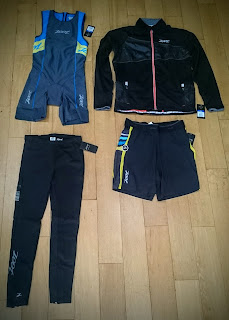Random musings from a large triathlete. Thoughts on kit, training, physiology, races, and anything else I think might be of interest!
Thursday, 29 December 2016
Threshold Part 3 - Mathematical Thresholds
So far I've looked at the biochemistry behind thresholds, and evidence for whether thresholds exist (it appears they do, but not the one we all call 'threshold'!). For this post I'm going to look at some of the ways that we have tried to describe our thresholds and limits.
Monday, 26 December 2016
Combining Zwift with Sufferfest/PerfPro (or TrainerRoad)
Wednesday, 16 November 2016
Zwift on a Budget
A few people have been concerned about how much it might cost to run Zwift, particularly if you're going to end up leaving the computer in the garage for ease of access. So I thought I'd document my setup to show you can run it on fairly old kit.
Wednesday, 31 August 2016
Zoot Makai Shoes
Sunday, 7 August 2016
Cheap solution to prevent bottle launching

I'm a big fan of XLabs and their behind-the-saddle bottle mounts; but I'm sure most people who have mounted bottles there have at some point experienced 'bottle launching'. This is at best annoying, and at worst could totally derail a long distance nutrition plan. I'm aware XLabs sell a 'Gorilla' cage which they state will prevent launching, but they're very expensive and British road surfaces are pretty ingenious in that regard.
I've always used the cheap 'Elite' cages which are available in all sorts of colours, and have a rubber tab which holds on to bottles fairly well. However, after a recent launching episode I thought I'd try something new.
Step up, 80mm nitrile rubber o-ring. (I bought them from Amazon but I'm sure you can find them elsewhere). Wrapped as per the photo, they add a bit of friction to the cage and seem to work very well - certainly no issues in a recent race where I saw quite a few cages (Gorillas included) shedding their load.
Feel free to share any other top tips in the comments!
Saturday, 30 July 2016
Outlaw Triathlon 2016
Monday, 18 July 2016
Monday, 23 May 2016
Illness and HRV
Wednesday, 30 March 2016
Xiaomi Mi Band 1S
Tuesday, 1 March 2016
Threshold Part 2 - What is a threshold?
Monday, 1 February 2016
Threshold Part 1 - Introduction & Energy Systems
'Threshold' is a word you can't avoid in endurance sport. But what does it mean? And how do newer views of exercise physiology improve our understanding of where our barriers lie?
Most serious endurance athletes will have an idea of where their 'threshold' lies - whether FTP for cyclists, HM pace for runners, CSS for swimmers. The usual understanding is that above 'threshold', exercise is associated with a gradual rise in the evil lactic acid, which eventually causes the athlete to have to stop. Below threshold, lactate stays steady. Some models appear to allow the athlete to go on forever, but others suggest (and the real world demonstrates) that exhaustion still occurs, and the athlete must stop for what is presumably an entirely different reason.
I had this planned as one post, then two, then more - I'm not sure now, but I think breaking it up into bits is going to help avoid head-spinning.
I'll start with a quick review of energy systems:
Tuesday, 19 January 2016
Interval types
PPO, Pmax, FTP, VO2max: Reading the literature, and even blogs, on interval training can prove a nightmare as authors demonstrate that their chosen training method produces wonderful results - but leave you with the nightmare of working out how to carry out out in your garage.
I'm hoping in this post to go through a few terms I've seen and how they relate to each other so it's possible to use studies in your own training. This will assume you have a power meter (or software allowing you to use your turbo as a virtual power meter, eg PerfPro or Trainerroad).
I'll be describing intensities in terms of FTP; not because I agree with FTP as a concept, but because it's the main metric used by power-geeks and their software.
Sunday, 17 January 2016
Four By Four
Simply put:
- Warm up (I usually take about 15 minutes, with some bursts)
- 4 minutes on
- 3 minutes off (some people take 4 but I find it's too much)
- Repeat for a total of 4
Thursday, 7 January 2016
Stash!
Tuesday, 5 January 2016
LePirate Belay Glasses
Friday, 1 January 2016
Another attempt
Attempts at perfection are the enemy of progress. I had a clear idea what I wanted to do with this blog, but frankly trying to make it perfect meant I rarely ended up publishing anything!
As part of some research work I've read about the CRAPL - an attempt to justify releasing half-baked code and ideas on the basis that it's far more useful for people to read something badly-written than to read nothing at all!
So I've binned off a fair bit of the blog, and will try to make a better effort to put stuff up here - on the basis that it'll not be quite what I intended, but more like a series of post-it notes with bits of information that hopefully you might find useful. I'm planning kit and race reviews, training ideas, and I have a keen interest in physiology so there'll probably be some geeked-out posts too.
I've become a member of Team Zoot Europe so there will probably be a fair bit of Zoot kit - I'm hopefully getting a pair of the new Makai shoes before too long to try out, amongst others. See you out there!













